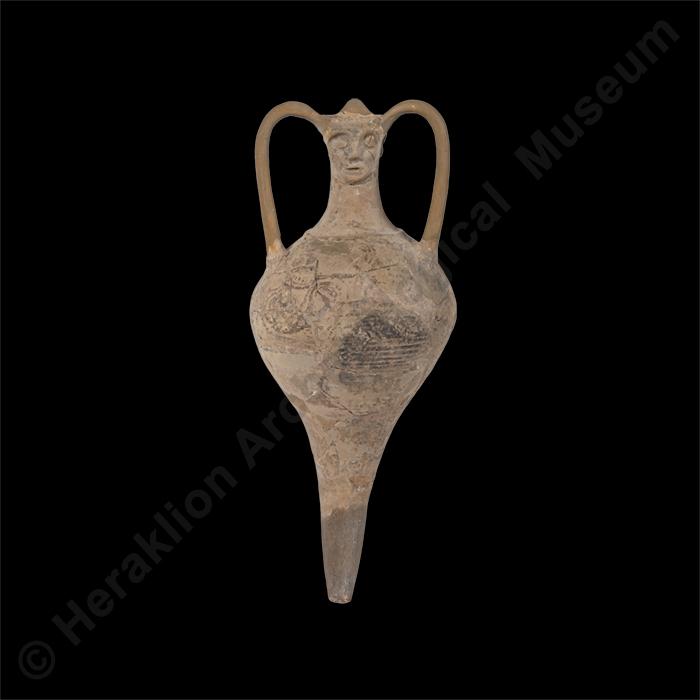Rhtyon with modelled human head
Π11050
Clay
Mended and restored on handles, rim and body.
Height: 28.5 cm. Maximum diameter: 14 cm. Rim diameter: 5.6 cm.
Karphi
Settlement
Late Bronze Age. Postpalatial period, Late Minoan IIIC period.:
1200 - 1070 BC:
Gallery:
XICase:
117Exhibition thematic unit:
Late Bronze Age - Postpalatial period (1300-1100 BC). Settlements. Sanctuaries. TombsCommunal shrines
Description
Pointed piriform rhyton with three handles and anthropomorphic relief decoration. A face, probably male, is rendered in relief on the neck of the vase, while the human form is incorporated in the shape of the vessel without distorting it. The eyebrows, eyes, mouth and ears are present and highlighted in flaking brownish-black paint. The upper body of the vessel is decorated in the same colour but the motifs are unclear due to the poor preservation of the paint. The vase was found in Area 27 of the South Houses of the settlement together with another rhyton (Π11046). Vessels of this type, incorporating relief human figures on the body or in the shape of a human head, appear in Late Minoan IIIB and IIIC. They reveal the importance of the human face as a bearer of religious or social meanings and values.Bibliography:
Koehl, R.B. Aegean Bronze Age Rhyta. Prehistory Monographs 19. Philadelphia, 2006, 24, 86, fig. 5:88. Pendlebury, H.W., Pendlebury, J.D.S., Money-Coutts, M.B. "Excavations in the Plain of Lasithi. III. Karphi. A City of Refuge in the Early Iron Age in Crete." Annual of the British School at Athens 38 (1937-1938): 57-145. Prent, M. Cretan Sanctuaries and Cults. Continuity and Change from Late Minoan IIIC to the Archaic Period. Leiden and Boston, 2005, 137-146, 193-194. Rethemiotakis, G. Ανθρωπομορφική Πηλοπλαστική στην Κρήτη από τη Νεοανακτορική έως την Υπομινωική Περίοδο. Βιβλιοθήκη της εν Αθήναις Αρχαιολογικής Εταιρείας no. 174. Athens, 1998, 22, 77-79, fig. 50.Author:
E. S.Photographs' metadata
